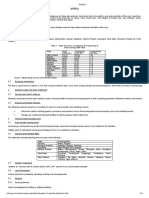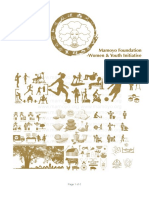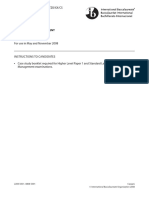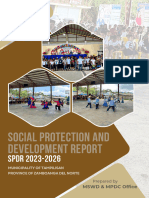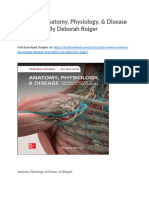Professional Documents
Culture Documents
Case Study Observation On Challenges To Adopt Intensive Livestock Farming Systems in East New Britain Province
Original Title
Copyright
Available Formats
Share this document
Did you find this document useful?
Is this content inappropriate?
Report this DocumentCopyright:
Available Formats
Case Study Observation On Challenges To Adopt Intensive Livestock Farming Systems in East New Britain Province
Copyright:
Available Formats
Volume 6, Issue 2, February – 2021 International Journal of Innovative Science and Research Technology
ISSN No:-2456-2165
Case Study: Observation on Challenges to Adopt
Intensive Livestock Farming Systems in East New
Britain Province
Limai Lan and Famundi Naoka
Papua New Guinea University of Natural Resources and Environment,
Private Mail Bag Service, Kokopo, East New Britain Province
Abstract:- The study was done in Gazelle District of East The current investigation reveals that there is no
New Britain Province from October-November, 2020. adoption of intensive livestock system in Gazelle district
Cluster farmer groups of four ecological communities representative of East New Britain Province. Higher number
were randomly selected for the study. It was conducted of farmers (53%) responded with the reason being “lack of
to assess the adoption of two farming systems; extensive training” for livestock farmers.
and intensive farming systems. Four constrains were
introduced to the farmers to provide likelihood evidence II. MATERIALS AND METHODS
on lack of livestock intensification. The data was
processed using spread sheet MS 2010 to present the Ecological zones
parameter proportions in pie charts. Lack of livestock East New Britain province is demarcated with four
knowledge and skills (53%) was identified as one of the administrative zones, Rabaul, Kokopo, Gazelle and Pomio
main challenges of livestock intensification in rural with a land mass of 15,816 km2. East New Britain province
farming communities. Livestock farmers require has a population of 328, 369 (2011 national census) shares a
evaluation strategies from the co-corporative efforts of land border with West New Britain province and a marine
government agencies, economic facilitators and border with New Ireland province. The province operates its
institution to design a sustainable training package for cash economy heavily on subsistence sector, cocoa and
livestock farmers. copra being the main cash earners for the farmers.
(wikipidia.org, 2021). Gazelle district was included in the
Keywords:- Gazelle District, Cluster Farmer, study involving 40 local livestock farmers. Gazelle district
Intensification, Challenges. has the largest land mass with the highest population density
of 35km-2. Most people live on the Gazelle Peninsula where
I. INTRODUCTION the dominant ethnic group is the Tolai population with
expected high living standards (>200PGK person-1year-1)
Livestock is reared using various husbandry practices relative to most other regions of PNG (Hanson et al., 2001).
to produce food (meat, eggs, milk and other by-products) to Most people living on the Gazelle Peninsula have road
sustain food security for the growing population (Cornut et access to their villages. However, the Bainings and the
al., 2012; Gonzalez and Rodenas, 2020). Gonzalez and Pomios, are away from government services such as road
Rodenas, 2020, stressed the importance of livestock as it links which take several days to travel by foot from the
contributes 40% of total agriculture value to support nearest road to excess services from their villages (Liu. et
livelihoods of 1.3 billion people and is among the fastest al., 2002).
growing sector in Agriculture. This is achieved using
different animal species (swine, poultry, small and large Face-to-face interview using the designed
ruminants) utilizing different sets of resources, in a wide questionnaire was conducted based on the farming systems.
spectrum of agro-ecological and socio-economic conditions Four reasons were investigated to support significant
(Steinfeld et al., 2006). Given the diversified livestock adoption skills while the responses of the farmers were
species there are certain patterns of farming systems that recorded from four clusters of ten farmers. Farmers of Vudal
have been categorised into various livestock production block, Kereba block, Vunapalading block and Napapar2
systems. These systems have been defined on the basis of village were selected as study zones. The assessment
land use by livestock, and for this purpose the distinction include; assessing the farm structure, water supply, waste
between grazing systems, mixed farming systems and management, flock size, production level, feeds and feeding
industrial (or landless) systems has been widely accepted systems as primary indicators of intensive farming system.
(FAO,1994). This research is discussed based on the
adoption of livestock farming systems in East New Britain Livestock Farming Systems
province. Investigations are based on the interests to identify Extensive and intensive livestock farming systems
the constraints since establishment of DAL or other were assessed during the interview from October-
government institutions in Papua New Guinea. November, 2020. Extensive farming is practiced with small
flock size, small land area, low productivity per animal, and
IJISRT21FEB458 www.ijisrt.com 1024
Volume 6, Issue 2, February – 2021 International Journal of Innovative Science and Research Technology
ISSN No:-2456-2165
the farmers require less capital and resources (Gonzales and Data Analysis
Godenas, 2020). Livestock is not a committed responsibility The questionnaires were collated to calculate the
for a farmer. Most of the commercial practices are absent in frequencies of observed farmers. The parameters; intensive
this farming system. farming, extensive farming and the four challenges were
analysed using pie charts in the spread sheet 2010. These
On the other hand, intensive farming system is results are represented in the percentages with their
defined as a self-sufficient system with flock size targeting respective proportions.
high productivity per animal, proper housing, adequate
watering and feeding system, full time labour employment III. RESULTS AND DISCUSSIONS
and fixed market outlet. The animal system is calculated as
total impact per unit of product driven by production Common Types of Livestock Farming Systems
efficiency (Garnsworthy, 2012). There is 100% responses indicating existence of
extensive (conventional) farming practices within Gazelle
Village chickens, swine, ducks and broiler production District. Extensive farming system is a free-range
systems were observed during the survey. These livestock production practices with less commitments to improve
require small land area to become as an indicator of husbandry practices or increase production. These responses
intensified farming system of the surveyed zones. are relevant as it stretches to compliment the observations
done with Muscovy ducks (n=30 farmers) in 2012. In the
Given a certain arable land area, mixed farming survey of 2012, only 6% of farmers from Kokopo district
systems (“integrated farming system”) or other farming had an experience to raise Muscovy ducks while 56%
systems defined within either subsistence or extensive (Gazelle 15%, Kokopo 13% and Rabaul 29%) have no
farming systems (Rutenberg, 1971 & 1980) are options left knowledge on duck farming. The survey also indicated that
for the farmers. Sere and Steinfeld, 1996 described the land in the last twenty years adoption of Muscovy duck
use in proportions (cropping-15%, >10% dry matter management practices had been given less attention to
produced from crop residues or > 10% of the total value of improvement. The current observation showed no signs of
production comes from the non-livestock activities). A intensification in livestock farming system. Village chickens
commercial criterion has to be set inclusive of 10% are also farmed on free range in their back yards with poor
threshold production level (Thornton et al., 2002). However, management practices in the observed backyard farms
Kambou 1995 criticized stating that “there is no organised affecting reproduction and other economic traits.
livestock system, traditionally. The pigs, fowls and the
village chickens comprised the total complex system the
subsistence farmer engages.
Despite Muscovy ducks raised under various roofs production related to reasons admitted by farmers
(50%-sago roof, 33% -kunai grass and 33% -coconut interviewed.
fronds), production of Muscovy duck was low. Production
constraints exist in three districts (Gazelle, Kokopo and Challenges of Livestock Intensification
Rabaul) affecting 67% of farmers in Gazelle district The farmers admittance on the none adoption of
producing less than 10 duckling-1yr. Kokopo District has intensive farming system was directed towards lack of funds
44% of farmers producing less than five to ten ducklings-1yr. (incentives), Lack of knowledge & skills, Limited land area
Observations on swine production system are similar. and seasonal production. These are in the respective
Farmers raise swine on free range only to meet their cultural proportions of 17%, 53%, 15% and 15%. Higher number of
obligations. There are doubts to intensify livestock farmers lack required livestock knowledge to increase their
IJISRT21FEB458 www.ijisrt.com 1025
Volume 6, Issue 2, February – 2021 International Journal of Innovative Science and Research Technology
ISSN No:-2456-2165
capacities and level of innovation. In Muscovy duck survey which had badly resulted in very poor management practices
of 2012 responses on extension and training received the related to feeding, breeding and marketing of ducks. It is
claim that low duck production was experienced due to total believed from observations that similar constraints are faced
absence of extension services. Farmers of Gazelle, Kokopo by farmers concerning other livestock species leading to
and Rabaul districts lack improved duck farming skills experience low livestock production curves.
Limited land area was expressed with concerns that interests of repeated farming. The husbandry practices of
expansion to farm livestock on a larger production scale is formulating required feed nutrients, breeding programs,
inevitably impossible. Most farmers of surveyed areas are housing and diseases management skills are poorly adopted
settlers after the volcanic eruption in 1994. Each farmer to affect livestock intensification.
occupies an approximate land area of 500m2 with an
estimation average of less than 200 cocoa trees and Farmers also claimed to blame low income as one of
residential area. Most farmers identified land issue as one of the four main constraints identified during the survey. Low
the main socio-economic factors related to high population income is exceptionally correct for the farmers to state their
density (91m-2). Cornut et al., 2012 emphasised that the opinions relating to pricing challenges (Gonzales and
dynamics of family livestock farming in extensive livestock Godenas, 2020) to invest in their Small-Medium Enterprise
farming territories are crucial for the future of farming targeting the markets with uncertainness. Farmers are
communities. Since the farmers are sharing close boundaries unsure of sourcing funds such as from National Agriculture
raising livestock species like swine has its extended cultural Development Bank (NADB), commercial banks or other
problems related to production environment, intensities and micro-banks to facilitate the intended livestock farms.
purposes of production (Delgado. et al, 2007). Swine Establishing livestock farm is expensive with irregular
farming has its serious concerns drawing attention to its income earners relying heavily on cocoa as the main income
behaviour involved with damages to food crops in the generator. Low income has affected house hold livelihoods
gardens. Costales. et al, 2006 supports this by stating that with increasing living costs experienced elsewhere reducing
these systems are shaped by prevailing biophysical and the chances of potential livestock farmers to excel. To assist
socio-cultural environments, and without external inputs farmers excess funds based on livestock farming evaluations
they have traditionally been mostly in sustainable would help the farmers expand the production (Anton et al.,
equilibrium with such environments. This is a common 2016; IPC, www.AgriFin.org).
observed problem with high cultural threats exposed to
prevent farmers to expand livestock farms converted into IV. CONCLUSIONS
larger scales.
Adoption of livestock intensification farming systems
Limited land issue only creates a low-income option is poor as observed eight years ago during Muscovy duck
for farmers to participate in livestock production. The survey in 2012. Lack of knowledge and skills (53%) of a
farmers are scaled down to raise only less than five swine, livestock farmer has affected the growth on livestock
less than ten village chickens and a batch of broiler birds per improvement in farming systems. Livestock intensification
three months production cycle. They have marginalized requires a corporative effort from government agencies,
livestock production only to meet cultural obligations or economic facilitators and institutions to formulate the better
only to earn certain amount of income (Wilson, 2007) rather livestock training package for the rural farmers. Evaluations
than to optimize economic returns. The production practices with strategic approaches are relevant and should be
have increased production cycles and have lowered the
IJISRT21FEB458 www.ijisrt.com 1026
Volume 6, Issue 2, February – 2021 International Journal of Innovative Science and Research Technology
ISSN No:-2456-2165
designed to capture sustainability in livestock production for [12]. Ruthenberg, H, (1980). In Farming systems in the
rural farming communities. tropics. 3rd Ed (p. 424). Oxford, UK, Clarendon Press.
[13]. Ruthenberg, H, (1971). In Farming systems in the
V. ACKNOWLEDGEMENT tropics. 1st Ed (p. 313). Oxford, UK, Clarendon Press.
[14]. Seré.C., & H. Steinfeld, (1996). World Livestock
The authors wish to convey the following participants Production Systems: Current Status, Issues and
with words of appreciation during the time of study. Your Trends. FAO Animal Production and Health Paper
contributions are counted in numbers. No.127. FAO, Rome.
1. Barth Jeremy [15]. Steinfeld .H , T. Wassenaar & S. Jutzi, (2006).
2. Norman Ningihuni Livestock production systems in developing countries:
3. Amily John status, drivers, trends. Animal Production and Health
Division, Food and Agriculture Organization of the
REFERENCES United Nations, Viale delle Terme di Caracalla,
00100-Rome, Italy.
[1]. Antón G-Martínez, J. Rivas-Rangel, J. Rangel- [16]. Thornton, P. K., R.L Kruska, N. Henninger,P.M.
Quintos, J. Antonio- Espinosa, C. Barba and C. de- Kristjanson,R.S Reid, F.Atieno, A.N Odero,
Pablos-Heredero, (2016). A Methodological Approach T.Ndegwa, (2002). Mapping Poverty and Livestock in
to Evaluate Livestock Innovations on Small-Scale the Developing World. International Livestock
Farms in Developing Countries. Future Internet, pp. 1- Research Institute (ILRI).
17. [17]. Wikipedia. East New Britain Province.
[2]. Costales A., Gerber P. & Steinfeld H, (2006). https://en.wikipedia.org/wiki/East_New_Britain_Provi
Underneath the livestock revolution. In Livestock nce [Retrieved January, 2021).
Report 2006 (pp. 15-27). Food and Agriculture [18]. Wilson T. O, (2007). MAKING AGRICULTURE
Organization, Rome. COMMERCIAL IN PNG . Farmers & Settlers
[3]. Cournut. S., J. Rhyscawy, C. Corniaux, S. Madelrieux, Association Inc. .
(2012). Dynamics of Livestock Farming in extensive
livestock farming territories: What processes are going
on?
[4]. Delgado C., Narrod C. & Tiongco M. . (2007).
Determinants and implications of the growing scale of
livestock farms in four fast-growing developing
countries. Research report (draft). . Washington DC:
International Food Policy Research Institute.
[5]. FAO, (1994). Farming Systems Development. Rome:
FOOD AND AGRICULTURE ORGANIZATION OF
THE UNITED NATIONS.
[6]. Gonzales -V. Pablo & Rodenas-B. Joel, (2020).
Extensive vs Intensive Farming. Yale Global
online.
[7]. Hanson, L W, Allen BJ, Bourke RM and McCarthy
T.J, (2001). Papua New Guinea Rural Development
Handbook. The Australian National University,
Canberra. .
[8]. IPC - Internationale Projekt Consult GmbH.
Agriculture Finance Support Facility.,
www.AgriFin.org) [Retrieved October 9, 2019]
[9]. Kambuou R.N ,(1995). CHAPTER 1: Papua New
Guinea and its Agricultural Economy. In Leipzig,
PAPUA NEW GUINEA: COUNTRY REPORT TO
THE FAO INTERNATIONAL TECHNICAL
CONFERENCE ON PLANT GENETIC RESOURCES
(p. 10).
[10]. Liu. M, A.Oliver and K.Woodford, (2002).
LIVELIHOOD TRAINING IN THE ISLANDS REGION
OF PAPUA NEW GUINEA: THE INTEGRATED
AGRICULTURAL TRAINING PROGRAM . Lincoln
University, NZ .
[11]. Phil Garnsworthy, (2012). Sustainable intensive
farming system. EAAP Scientific series, University of
Nottinghem.
IJISRT21FEB458 www.ijisrt.com 1027
You might also like
- The Subtle Art of Not Giving a F*ck: A Counterintuitive Approach to Living a Good LifeFrom EverandThe Subtle Art of Not Giving a F*ck: A Counterintuitive Approach to Living a Good LifeRating: 4 out of 5 stars4/5 (5794)
- Formulation and Evaluation of Poly Herbal Body ScrubDocument6 pagesFormulation and Evaluation of Poly Herbal Body ScrubInternational Journal of Innovative Science and Research TechnologyNo ratings yet
- The Little Book of Hygge: Danish Secrets to Happy LivingFrom EverandThe Little Book of Hygge: Danish Secrets to Happy LivingRating: 3.5 out of 5 stars3.5/5 (399)
- Comparatively Design and Analyze Elevated Rectangular Water Reservoir with and without Bracing for Different Stagging HeightDocument4 pagesComparatively Design and Analyze Elevated Rectangular Water Reservoir with and without Bracing for Different Stagging HeightInternational Journal of Innovative Science and Research TechnologyNo ratings yet
- A Heartbreaking Work Of Staggering Genius: A Memoir Based on a True StoryFrom EverandA Heartbreaking Work Of Staggering Genius: A Memoir Based on a True StoryRating: 3.5 out of 5 stars3.5/5 (231)
- Explorning the Role of Machine Learning in Enhancing Cloud SecurityDocument5 pagesExplorning the Role of Machine Learning in Enhancing Cloud SecurityInternational Journal of Innovative Science and Research TechnologyNo ratings yet
- Hidden Figures: The American Dream and the Untold Story of the Black Women Mathematicians Who Helped Win the Space RaceFrom EverandHidden Figures: The American Dream and the Untold Story of the Black Women Mathematicians Who Helped Win the Space RaceRating: 4 out of 5 stars4/5 (894)
- A Review: Pink Eye Outbreak in IndiaDocument3 pagesA Review: Pink Eye Outbreak in IndiaInternational Journal of Innovative Science and Research TechnologyNo ratings yet
- The Yellow House: A Memoir (2019 National Book Award Winner)From EverandThe Yellow House: A Memoir (2019 National Book Award Winner)Rating: 4 out of 5 stars4/5 (98)
- Design, Development and Evaluation of Methi-Shikakai Herbal ShampooDocument8 pagesDesign, Development and Evaluation of Methi-Shikakai Herbal ShampooInternational Journal of Innovative Science and Research Technology100% (3)
- Shoe Dog: A Memoir by the Creator of NikeFrom EverandShoe Dog: A Memoir by the Creator of NikeRating: 4.5 out of 5 stars4.5/5 (537)
- Studying the Situation and Proposing Some Basic Solutions to Improve Psychological Harmony Between Managerial Staff and Students of Medical Universities in Hanoi AreaDocument5 pagesStudying the Situation and Proposing Some Basic Solutions to Improve Psychological Harmony Between Managerial Staff and Students of Medical Universities in Hanoi AreaInternational Journal of Innovative Science and Research TechnologyNo ratings yet
- Elon Musk: Tesla, SpaceX, and the Quest for a Fantastic FutureFrom EverandElon Musk: Tesla, SpaceX, and the Quest for a Fantastic FutureRating: 4.5 out of 5 stars4.5/5 (474)
- A Survey of the Plastic Waste used in Paving BlocksDocument4 pagesA Survey of the Plastic Waste used in Paving BlocksInternational Journal of Innovative Science and Research TechnologyNo ratings yet
- Never Split the Difference: Negotiating As If Your Life Depended On ItFrom EverandNever Split the Difference: Negotiating As If Your Life Depended On ItRating: 4.5 out of 5 stars4.5/5 (838)
- Electro-Optics Properties of Intact Cocoa Beans based on Near Infrared TechnologyDocument7 pagesElectro-Optics Properties of Intact Cocoa Beans based on Near Infrared TechnologyInternational Journal of Innovative Science and Research TechnologyNo ratings yet
- Grit: The Power of Passion and PerseveranceFrom EverandGrit: The Power of Passion and PerseveranceRating: 4 out of 5 stars4/5 (587)
- Auto Encoder Driven Hybrid Pipelines for Image Deblurring using NAFNETDocument6 pagesAuto Encoder Driven Hybrid Pipelines for Image Deblurring using NAFNETInternational Journal of Innovative Science and Research TechnologyNo ratings yet
- Devil in the Grove: Thurgood Marshall, the Groveland Boys, and the Dawn of a New AmericaFrom EverandDevil in the Grove: Thurgood Marshall, the Groveland Boys, and the Dawn of a New AmericaRating: 4.5 out of 5 stars4.5/5 (265)
- Cyberbullying: Legal and Ethical Implications, Challenges and Opportunities for Policy DevelopmentDocument7 pagesCyberbullying: Legal and Ethical Implications, Challenges and Opportunities for Policy DevelopmentInternational Journal of Innovative Science and Research TechnologyNo ratings yet
- Navigating Digitalization: AHP Insights for SMEs' Strategic TransformationDocument11 pagesNavigating Digitalization: AHP Insights for SMEs' Strategic TransformationInternational Journal of Innovative Science and Research TechnologyNo ratings yet
- Hepatic Portovenous Gas in a Young MaleDocument2 pagesHepatic Portovenous Gas in a Young MaleInternational Journal of Innovative Science and Research TechnologyNo ratings yet
- The Emperor of All Maladies: A Biography of CancerFrom EverandThe Emperor of All Maladies: A Biography of CancerRating: 4.5 out of 5 stars4.5/5 (271)
- Review of Biomechanics in Footwear Design and Development: An Exploration of Key Concepts and InnovationsDocument5 pagesReview of Biomechanics in Footwear Design and Development: An Exploration of Key Concepts and InnovationsInternational Journal of Innovative Science and Research TechnologyNo ratings yet
- On Fire: The (Burning) Case for a Green New DealFrom EverandOn Fire: The (Burning) Case for a Green New DealRating: 4 out of 5 stars4/5 (73)
- Automatic Power Factor ControllerDocument4 pagesAutomatic Power Factor ControllerInternational Journal of Innovative Science and Research TechnologyNo ratings yet
- The Hard Thing About Hard Things: Building a Business When There Are No Easy AnswersFrom EverandThe Hard Thing About Hard Things: Building a Business When There Are No Easy AnswersRating: 4.5 out of 5 stars4.5/5 (344)
- Formation of New Technology in Automated Highway System in Peripheral HighwayDocument6 pagesFormation of New Technology in Automated Highway System in Peripheral HighwayInternational Journal of Innovative Science and Research TechnologyNo ratings yet
- Team of Rivals: The Political Genius of Abraham LincolnFrom EverandTeam of Rivals: The Political Genius of Abraham LincolnRating: 4.5 out of 5 stars4.5/5 (234)
- Drug Dosage Control System Using Reinforcement LearningDocument8 pagesDrug Dosage Control System Using Reinforcement LearningInternational Journal of Innovative Science and Research TechnologyNo ratings yet
- The Effect of Time Variables as Predictors of Senior Secondary School Students' Mathematical Performance Department of Mathematics Education Freetown PolytechnicDocument7 pagesThe Effect of Time Variables as Predictors of Senior Secondary School Students' Mathematical Performance Department of Mathematics Education Freetown PolytechnicInternational Journal of Innovative Science and Research TechnologyNo ratings yet
- Mobile Distractions among Adolescents: Impact on Learning in the Aftermath of COVID-19 in IndiaDocument2 pagesMobile Distractions among Adolescents: Impact on Learning in the Aftermath of COVID-19 in IndiaInternational Journal of Innovative Science and Research TechnologyNo ratings yet
- Securing Document Exchange with Blockchain Technology: A New Paradigm for Information SharingDocument4 pagesSecuring Document Exchange with Blockchain Technology: A New Paradigm for Information SharingInternational Journal of Innovative Science and Research TechnologyNo ratings yet
- Perceived Impact of Active Pedagogy in Medical Students' Learning at the Faculty of Medicine and Pharmacy of CasablancaDocument5 pagesPerceived Impact of Active Pedagogy in Medical Students' Learning at the Faculty of Medicine and Pharmacy of CasablancaInternational Journal of Innovative Science and Research TechnologyNo ratings yet
- The Unwinding: An Inner History of the New AmericaFrom EverandThe Unwinding: An Inner History of the New AmericaRating: 4 out of 5 stars4/5 (45)
- Intelligent Engines: Revolutionizing Manufacturing and Supply Chains with AIDocument14 pagesIntelligent Engines: Revolutionizing Manufacturing and Supply Chains with AIInternational Journal of Innovative Science and Research TechnologyNo ratings yet
- The World Is Flat 3.0: A Brief History of the Twenty-first CenturyFrom EverandThe World Is Flat 3.0: A Brief History of the Twenty-first CenturyRating: 3.5 out of 5 stars3.5/5 (2219)
- Enhancing the Strength of Concrete by Using Human Hairs as a FiberDocument3 pagesEnhancing the Strength of Concrete by Using Human Hairs as a FiberInternational Journal of Innovative Science and Research TechnologyNo ratings yet
- Exploring the Clinical Characteristics, Chromosomal Analysis, and Emotional and Social Considerations in Parents of Children with Down SyndromeDocument8 pagesExploring the Clinical Characteristics, Chromosomal Analysis, and Emotional and Social Considerations in Parents of Children with Down SyndromeInternational Journal of Innovative Science and Research TechnologyNo ratings yet
- Supply Chain 5.0: A Comprehensive Literature Review on Implications, Applications and ChallengesDocument11 pagesSupply Chain 5.0: A Comprehensive Literature Review on Implications, Applications and ChallengesInternational Journal of Innovative Science and Research TechnologyNo ratings yet
- The Gifts of Imperfection: Let Go of Who You Think You're Supposed to Be and Embrace Who You AreFrom EverandThe Gifts of Imperfection: Let Go of Who You Think You're Supposed to Be and Embrace Who You AreRating: 4 out of 5 stars4/5 (1090)
- Teachers' Perceptions about Distributed Leadership Practices in South Asia: A Case Study on Academic Activities in Government Colleges of BangladeshDocument7 pagesTeachers' Perceptions about Distributed Leadership Practices in South Asia: A Case Study on Academic Activities in Government Colleges of BangladeshInternational Journal of Innovative Science and Research TechnologyNo ratings yet
- Advancing Opthalmic Diagnostics: U-Net for Retinal Blood Vessel SegmentationDocument8 pagesAdvancing Opthalmic Diagnostics: U-Net for Retinal Blood Vessel SegmentationInternational Journal of Innovative Science and Research TechnologyNo ratings yet
- The Making of Self-Disposing Contactless Motion-Activated Trash Bin Using Ultrasonic SensorsDocument7 pagesThe Making of Self-Disposing Contactless Motion-Activated Trash Bin Using Ultrasonic SensorsInternational Journal of Innovative Science and Research TechnologyNo ratings yet
- Natural Peel-Off Mask Formulation and EvaluationDocument6 pagesNatural Peel-Off Mask Formulation and EvaluationInternational Journal of Innovative Science and Research TechnologyNo ratings yet
- The Sympathizer: A Novel (Pulitzer Prize for Fiction)From EverandThe Sympathizer: A Novel (Pulitzer Prize for Fiction)Rating: 4.5 out of 5 stars4.5/5 (119)
- Beyond Shelters: A Gendered Approach to Disaster Preparedness and Resilience in Urban CentersDocument6 pagesBeyond Shelters: A Gendered Approach to Disaster Preparedness and Resilience in Urban CentersInternational Journal of Innovative Science and Research TechnologyNo ratings yet
- Handling Disruptive Behaviors of Students in San Jose National High SchoolDocument5 pagesHandling Disruptive Behaviors of Students in San Jose National High SchoolInternational Journal of Innovative Science and Research TechnologyNo ratings yet
- Project Proposal Template PDFDocument14 pagesProject Proposal Template PDFKabir MasudNo ratings yet
- Agriculture 12 01773 v2Document21 pagesAgriculture 12 01773 v2Katleho MokheleNo ratings yet
- Modules On Neoliberal Globalization Web PDFDocument54 pagesModules On Neoliberal Globalization Web PDFKarlo Mikhail MongayaNo ratings yet
- Seminar Presentation ON: Agriculture Marketing (Nature, Scope & Objectives)Document11 pagesSeminar Presentation ON: Agriculture Marketing (Nature, Scope & Objectives)sayyed munirNo ratings yet
- Organic Market Report 2008: AustralianDocument45 pagesOrganic Market Report 2008: AustralianPanatda OnnomNo ratings yet
- Aonla PDFDocument4 pagesAonla PDFRajNo ratings yet
- Introduction to Agribusiness: From Farming to a Technology-Oriented IndustryDocument20 pagesIntroduction to Agribusiness: From Farming to a Technology-Oriented IndustryVijay Dahiya100% (1)
- Anbes Tenaye Agri. Econ. 2003Document150 pagesAnbes Tenaye Agri. Econ. 2003Rafez JoneNo ratings yet
- Visit to Venky’s Poultry farm in PanipatDocument12 pagesVisit to Venky’s Poultry farm in PanipatMubarak Ali0% (1)
- The Role of The Private Sector in Agriculture Extension in PakistanDocument8 pagesThe Role of The Private Sector in Agriculture Extension in Pakistanshahidmrd100% (2)
- Her Body and Other Parties: StoriesFrom EverandHer Body and Other Parties: StoriesRating: 4 out of 5 stars4/5 (821)
- Vertical Integration in Bangladesh AgricultureDocument12 pagesVertical Integration in Bangladesh AgricultureMahmudur RahmanNo ratings yet
- Future Land Use + Development Guidelines: Johnson County, Iowa - Comprehensive PlanDocument7 pagesFuture Land Use + Development Guidelines: Johnson County, Iowa - Comprehensive PlanconfluencescribdNo ratings yet
- Poultry Production and Marketing Project Kitui, KenyaDocument11 pagesPoultry Production and Marketing Project Kitui, KenyaPramod Kumar Chaudhary100% (1)
- 01 1 Mini Farm ProposalDocument6 pages01 1 Mini Farm Proposalapi-388330593No ratings yet
- Business and Management Paper 1 Case Study HLSLDocument6 pagesBusiness and Management Paper 1 Case Study HLSLZEEL PATELNo ratings yet
- North West Development Authority in The Development of The Northwest Region of Cameroon, 1981-2019Document9 pagesNorth West Development Authority in The Development of The Northwest Region of Cameroon, 1981-2019International Journal of Arts, Humanities and Social Studies (IJAHSS)No ratings yet
- Chapter 5Document60 pagesChapter 5MiliyonNo ratings yet
- Stefan Bauschard Famine AnswersDocument73 pagesStefan Bauschard Famine AnswersEthan JacobsNo ratings yet
- The Balanced Scorecard Required Develop A Balanced Scorecard With ThreeDocument2 pagesThe Balanced Scorecard Required Develop A Balanced Scorecard With ThreeAmit PandeyNo ratings yet
- Countryside - Lesson NotesDocument10 pagesCountryside - Lesson Noteslinh myNo ratings yet
- SPDR TampiDocument68 pagesSPDR TampiJosephine Templa-JamolodNo ratings yet
- Omnivores DilemmaTG PDFDocument32 pagesOmnivores DilemmaTG PDFPedro Taveras100% (3)
- G8 English Ch1-3Document37 pagesG8 English Ch1-3Asteway MesfinNo ratings yet
- CBLM - MPDCI (Perform Pre-Lay and Lay Activities)Document33 pagesCBLM - MPDCI (Perform Pre-Lay and Lay Activities)robelyn verano100% (4)
- THM03 MODULE 3 Tourism and CultureDocument11 pagesTHM03 MODULE 3 Tourism and Culturekathmb7380No ratings yet
- GG GR Crops Rules V5-0 enDocument7 pagesGG GR Crops Rules V5-0 ennmmartinsaNo ratings yet
- Forage Production in UgandaDocument23 pagesForage Production in UgandaVilasNo ratings yet
- Test Bank Anatomy Physiology Disease 2nd Edition by Deborah RoigerDocument37 pagesTest Bank Anatomy Physiology Disease 2nd Edition by Deborah Roigerdelmeembonyeb100% (15)
- The Industrial Revolution and Land TransformationDocument32 pagesThe Industrial Revolution and Land TransformationTayyba BatoolNo ratings yet
- Complete Project Report - Organic Farm Performance in MinnesotaDocument8 pagesComplete Project Report - Organic Farm Performance in MinnesotaMukesh ManwaniNo ratings yet
- Sully: The Untold Story Behind the Miracle on the HudsonFrom EverandSully: The Untold Story Behind the Miracle on the HudsonRating: 4 out of 5 stars4/5 (103)
- The Fabric of Civilization: How Textiles Made the WorldFrom EverandThe Fabric of Civilization: How Textiles Made the WorldRating: 4.5 out of 5 stars4.5/5 (57)
- Packing for Mars: The Curious Science of Life in the VoidFrom EverandPacking for Mars: The Curious Science of Life in the VoidRating: 4 out of 5 stars4/5 (1395)
- The Beekeeper's Lament: How One Man and Half a Billion Honey Bees Help Feed AmericaFrom EverandThe Beekeeper's Lament: How One Man and Half a Billion Honey Bees Help Feed AmericaNo ratings yet
- The Weather Machine: A Journey Inside the ForecastFrom EverandThe Weather Machine: A Journey Inside the ForecastRating: 3.5 out of 5 stars3.5/5 (31)
- Hero Found: The Greatest POW Escape of the Vietnam WarFrom EverandHero Found: The Greatest POW Escape of the Vietnam WarRating: 4 out of 5 stars4/5 (19)
- Faster: How a Jewish Driver, an American Heiress, and a Legendary Car Beat Hitler's BestFrom EverandFaster: How a Jewish Driver, an American Heiress, and a Legendary Car Beat Hitler's BestRating: 4 out of 5 stars4/5 (28)







































































